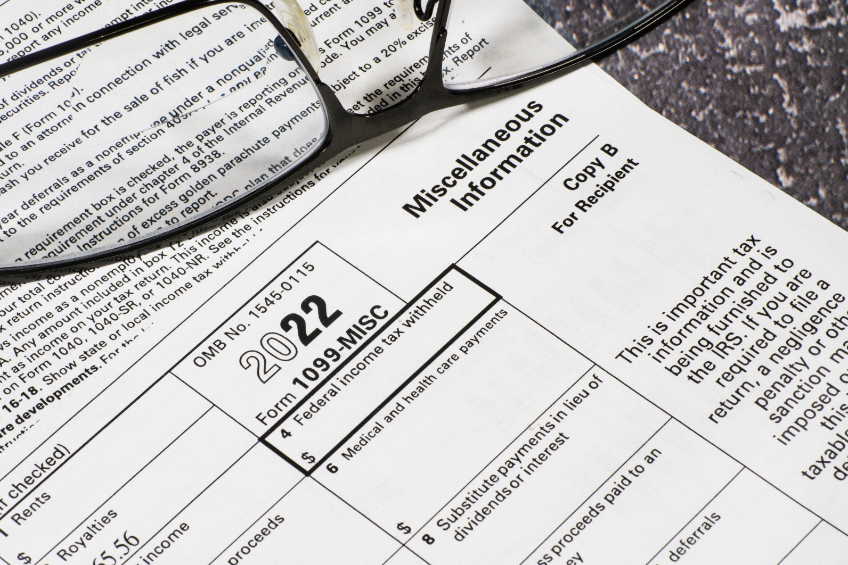Know Before You File: The 1099 Reporting Requirements for Business Owners
Published:
The Internal Revenue Service (IRS) requires all businesses to report certain payment transactions on the Form 1099 series on their tax returns. The 1099 reporting requirements were established to ensure that people receiving non-employment income pay federal income taxes accordingly. The 1099 series includes forms for various types of payments such as rent, royalties, non-employee compensation, interest income, and more. This reporting system is significant because it helps the IRS keep track of income from non-traditional sources and ensure that taxpayers are accurately reporting their income. Additionally, it helps businesses stay compliant with federal tax laws and avoid penalties for failing to report the required information on their tax returns.
Purpose and Significance of 1099 Reporting Requirements
The purpose and significance of 1099 reporting requirements cannot be overstated when it comes to ensuring compliance with federal tax laws for businesses. One of the most critical aspects of 1099 reporting requirements is the need to correctly classify workers as employees or independent contractors. This determination is crucial because it directly affects the type of tax forms that businesses must file for their workers, as well as the amount of taxes that the workers and businesses must pay.
To comply with the requirements, businesses must obtain and keep a completed and signed Form W-9 for all payments exceeding $600. Failure to do so may result in penalties and legal issues. The Form W-9 is used to identify and verify the name, address, and taxpayer identification number (TIN) of the recipient, helping businesses to report the appropriate income information to the IRS.
The types of payments that require 1099 reporting include non-employee compensation, substitute payments, and federal income tax withheld payments, among others. Non-employee compensation refers to payments made to independent contractors for services rendered. Substitute payments are payments made to a recipient in lieu of dividends or other earnings. Meanwhile, federal income tax withheld payments are payments to employees from their wages.
It is essential to note that each type of 1099 form has a minimum reportable amount. For instance, 1099-MISC forms are required if a business pays at least $600 in non-employee compensation to an individual or business. The minimum reportable amount for 1099-B forms is $10, while the threshold for payment card transactions is $20,000. Failure to file these forms when required may result in expensive penalties, interest charges, and legal problems for businesses.
In conclusion, the purpose and significance of 1099 reporting requirements lay in ensuring compliance with federal tax laws and helping businesses avoid penalties. Correctly classifying workers as employees or contractors and having completed and signed Form W-9s for all payments exceeding $600 is of utmost importance. Furthermore, businesses must understand that certain payments require 1099 reporting and should be aware of the minimum reportable amount for each type of 1099 form.
Types of Payments that Require 1099 Reporting
There are various types of payments that require 1099 reporting, ranging from payments made to independent contractors and business owners to life insurance contract proceeds and Archer MSA distributions. Non-employee compensation payments are among the most common, referring to payments made to independent contractors for their services. Substitute payments, which are made in lieu of dividends or other earnings, and federal income tax withheld payments also require reporting. Additionally, Social Security and Medicare tax withheld payments, crop insurance proceeds, life insurance contract proceeds, Archer MSA distributions, and business owner’s distribution payments are subject to 1099 reporting. Whether you’re electronic filing or submitting paper forms when reporting payments to self-employed individuals or 1099 contractors, those withholding requirements matter, especially for an individual’s Social Security and Archer MSA payments. Additionally, payment card networks and third-party payment processing providers are required to document payments and report them to the IRS.
Finally, the newly introduced 1099-NEC is specifically designed to report nonemployee compensation payments. Understanding these types of payments is necessary to ensure that businesses meet their reporting requirements and remain compliant with federal tax laws.
Independent Contractor Payments
Independent Contractor Payments refer to payments made to individuals who are contracted to perform services for a business but are not considered employees. Unlike employees, independent contractors have control over how and when the work is performed and are not subject to the same tax withholding requirements.
To properly document and report Independent Contractor Payments, businesses must ensure that the individual meets the conditions of an independent contractor. These conditions generally include having control over how the work is performed, providing their own equipment and supplies, and being able to work for multiple clients.
To report Independent Contractor Payments, businesses must issue a Form 1099-MISC to the individual and file a copy with the IRS. It is important to accurately document all payments made to independent contractors and ensure that the correct amount is reported on the 1099-MISC form.
There are different types of payments to independent contractors that require 1099 reporting, including nonemployee compensation, rent payments, and royalty payments. The threshold for reporting nonemployee compensation is $600 or more in a calendar year, while rent and royalty payments have a threshold of $600 or more paid to an individual or entity. It is important to note that these thresholds may change based on the specific type and IRS regulations.
Proper documentation and reporting of Independent Contractor Payments is crucial to ensure compliance with IRS regulations and avoid potential penalties. Understanding the conditions for independent contractor status and the different types of payments that require reporting is essential for businesses working with independent contractors.
Non-Employee Compensation Payments
Non-employee Compensation Payments are payments made to individuals or businesses for services performed that are not considered employees. Examples of these payments include payments to independent contractors, freelancers, consultants, and other outsourced service providers.
To properly report these payments, businesses must use Form 1099-NEC (Non-Employee Compensation). This form is specifically designed to document and report non-employee compensation payments to the Internal Revenue Service (IRS).
To determine if a payment should be reported on a 1099-NEC form, the payment must have been made for services performed in the course of your trade or business, and the total non-employee compensation paid to the individual or business must be at least $600 for the year. For example, if a business hires an independent contractor to perform web development services and pays them a total of $800 during the year, then the business is required to file a 1099-NEC form to report it.
A Form 1099-NEC must be filed if federal income tax was withheld under the backup withholding rules. Backup withholding rules require businesses to withhold a portion of payments made to individuals or businesses who have failed to provide their taxpayer identifying number (TIN), or who have provided an incorrect TIN.
In conclusion, understanding the reporting requirements for non-employee compensation payments using Form 1099-NEC is crucial to ensure compliance with IRS regulations. Reporting all payments made for services performed in the course of your trade or business that meet the minimum threshold of $600, and all payments subject to backup withholding rules appropriately on Form 1099-NEC is essential to avoid potential penalties and issues with the IRS in the future.
Substitute Payments
Substitute Payments are payments made in lieu of dividend or interest payments. This usually occurs in securities lending transactions, where a borrower agrees to provide the collateral to the lender in exchange for a fee. The fee paid by the borrower is considered a substitute payment and is subject to IRS reporting requirements.
Under certain reporting requirements, such as those outlined in IRS Publication 1179, substitute payments must be reported on Form 1099-MISC or Form 1099-B. Accurately reporting these payments is crucial for proper reporting to the IRS in compliance with federal income tax laws.
Additionally, reporting substitute payments on the correct form and in the correct box on the form is also important. Failure to report these payments accurately could result in penalties and issues with the IRS in the future.
Business owners should keep in mind that they must issue a Form 1099-MISC or Form 1099-B to any individuals or businesses who receive substitute payments of $600 or more during the year.
In conclusion, understanding and complying with the 1099 reporting requirements for substitute payments is crucial for proper reporting to the IRS. Accurately reporting these payments on the appropriate form and in the correct box will help to avoid penalties and potential issues with the IRS down the line.
Archer MSA Distributions
Archer MSA (Medical Savings Account) is a tax-advantaged account that can be used to pay for qualified medical expenses. If a medical insurer pays medical expenses through an Archer MSA account, and not through a third-party, then the reporting requirements for Archer MSA distributions come into play. Specifically, if the total distribution amount exceeds the medical expenses that were paid through the account, then that excess amount must be reported as taxable income.
To report Archer MSA distributions, the issuer of the account must complete Form 1099-SA. The form should include the account holder’s name, address, and Social Security number or tax identification number. The issuer must also report the total amount of distributions made during the tax year, including any amount that was used to pay for qualified medical expenses. In addition, the form should indicate whether the distributions were made from a traditional Archer MSA or a Medicare Advantage MSA.
It’s important to note that only distributions made from the Archer MSA account can be considered as tax-free if the expenses meet the definition of a qualified medical expense. The employer or financial institution that established the Archer MSA is responsible for accurately reporting all distributions made throughout the year that are taxable events.
In summary, Archer MSA distributions must be reported on Form 1099-SA if they exceed the amount of medical expenses paid through the account. To avoid any confusion, it’s essential that the issuer of the Archer MSA account ensures they are correctly categorizing, reporting, and recording the distributions in accordance with the rules and regulations set forth by the Internal Revenue Service (IRS).
Business Owner’s Distribution Payment (1099-MISC)
As a business owner, you may need to issue a Business Owner’s Distribution Payment (1099-MISC) to report payments made to non-employees such as independent contractors and service providers. These payments may include distribution payments made to partners or shareholders.
When preparing Form 1099-MISC for these payments, it’s important to note that the total amount of the payment must be included in Box 1. This helps to ensure accurate reporting of non-employee compensation and simplifies the record-keeping process for both the business and the recipient of the payment.
It’s also important to keep in mind that the deadline for providing Form 1099-MISC to the payee is January 31st of the following year. Failure to provide this form on time can result in penalties and fines for the business owner.
Overall, properly reporting Business Owner’s Distribution Payment (1099-MISC) is an important aspect of managing your finances as a business owner. By adhering to reporting requirements and providing accurate documentation, you can ensure that your payments are properly recorded and reported.
Payment Card and Third Party Network Transactions (1099-K)
Payment Card and Third-Party Network Transactions (1099-K) are not the only types of tax forms you’ll need to be aware of if you’re required to report income. Other forms under the 1099 series include the 1099-MISC or 1099-Q forms, which are used for reporting various types of income such as royalty, subscription, and other non-employment income. The 1099-MISC form is used to report miscellaneous income, while the 1099-Q form is used to report payments from qualified education programs. It’s important to understand the different types of income that require reporting and which form to use to avoid any mistakes when filing your taxes.
Royalty, Subscription, and Other Income (1099-MISC or 1099-Q)
Royalty, subscription, and other income payments are a significant component of the payment landscape and must be reported for tax purposes. Royalty payments refer to payments made to the holder of a patent or copyright for the works produced under such rights. Subscription payments are recurring payments made by subscribers for access to products or services. Other income, on the other hand, includes all payments that do not fit into either of the above categories.
Regardless of the type of payment, it is crucial that they are reported to the IRS to ensure compliance with tax laws. The specific form required for reporting royalty, subscription, and other income payments depends on the nature of the income. For instance, royalty payments are reported via Form 1099-MISC, while subscription and other income payments are reported via Form 1099-Q.
It is important to note that both forms require the payer to provide copies of the same to the IRS and the payee by January 31st of every year. Failure to report such payments may result in adverse consequences, including but not limited to penalties and interest chargeable on the underreported amounts.
In conclusion, the payment of royalty, subscription, and other income payments must be reported according to the nature of the payment. Payers must ensure compliance with the reporting requirements via 1099-MISC or 1099-Q forms depending on the source of income.



